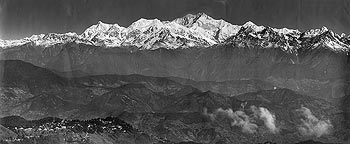Station Life
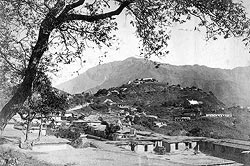 |
| View of Solon, 1890. (Click to enlarge) |
The garrisons of British troops in India between the two World Wars were located mainly in the north where their roles were to be in reserve for any possible disturbances on the North West Frontier and to preserve law and order in the principal areas. Most were close enough to the Himalayan foothills for relief to be obtained from the heat of the summer and the humidity of the monsoon. They were situated outside the towns and station life was a self-contained British one.
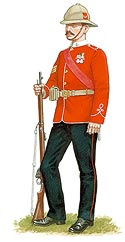 |
| Sergeant, 2nd Bn The East Surrey Regiment.
Review Dress Guard
of Honour fo the
Prince of Wales
c 1904 (India) (Click to enlarge) |
British Infantry regiments normally served up to twelve years in India changing location three or four times during that period. Soldiers enlisted for seven years with the Colours and five on the Reserve, and could extend to 21 years if accepted. Most of them spent several years in India during their Colour service with one or other of the battalions of their regiments. The trooping season was during the winter and the spring when reinforcement drafts arrived and time-expired soldiers returned home. Marching songs of those days included “Roll on my Seven and Five” and “They say there’s a troopship a-leaving Bombay, bound for old Blighty’s shore”, ‘Blighty’ being a corruption of the Urdu word for England. The bonds of friendship became very close when soldiering abroad and when the long-awaited day came for the soldier to leave the battalion which had been his home for so long there were often moving scenes as he said goodbye to the comrades with whom he had served for so many years.
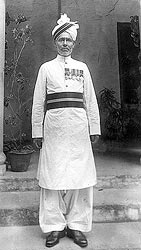 |
| Juma Khan, a bearer. (Click to enlarge) |
After disembarkation the first traumatic experience of India was the rail journey to the new station some 800 miles away which could take several days. Troop trains would halt in sidings for the cooking of breakfasts, dinners and teas, the times of meals were therefore somewhat uncertain, being dependent on the whereabouts of suitable sidings: Or carriages would be attached to regular stopping trains and meals, ordered ahead, taken at stations where the station master would come and ask permission to start. (There was also the officers’ complaints book - “The coffee had been drunk before.”) The unfortunate soldiers were liable to be crammed into carriages furnished with wooden seats and bunk beds, which could be oven-hot by day and bitterly cold in winter at night. Window shutters and fly screens kept out most of the dust and insects. Blocks of ice in tin baths were put into carriages with fans playing on them to reduce the heat. Railway stations were a bedlam of noise and movement that reached its peak as trains drew in or prepared to pull out. Vendors plied their wares -selling tea, water, fruit, nuts, or sweetmeats, each with their own identifying cry - and the railway coolies in red shirts and brass arm bands fought for the privilege of carrying huge loads for a pittance. At some stations monkeys would swarm all over the carriages and make off with any loose items.
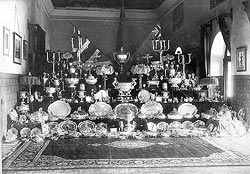 |
| 1st Bn The Queen’s Royal Regiment, Officers’ Mess silver, Rawalpindi 1902.) (Click to enlarge) |
For the newcomer to India who had not been abroad before, the extremes of climate were most marked. During the year the heat increased day by day until with the temperature over 100 degrees it was hard to believe it could get any hotter. And then, usually in July, came the monsoon with rain like stair rods and the accompanying discomfort of prickly heat and perpetual damp followed by the crisp clear days of autumn and the chill of winter nights.
The belief in the 1930s that a pith helmet was essential protection in the hot weather against the sun was not finally disproved until well into World War Two. But the spine pad was dispensed with earlier. It was intended to protect the spinal column from the effects of the sun. It consisted of a padded spinal pad provided with small cork wads to make an air space between coat and pad, and made to hook onto the coat. A report in the Regimental Journal November 1938 edition from the Queen’s at Allahabad stated that “The hot weather has been survived better than usual. Either we are hardier, or the Indian summer is less severe, or it may be the psychological effect of no longer wearing spine pads”.
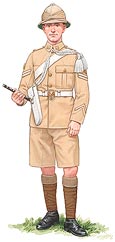 |
| Corporal, Corps of Drums, 1st Bn The Queen's Royal (West Surrey) Regiment
c 1922 (India) (Click to enlarge) |
Charles Allen in his “A Scrapbook of British India 1877 -1947” recalled that in mid-October the cold weather was officially stated to have begun, government allowances for punkah wallahs were stopped, and there was an overnight change from summer to winter clothing. Off came the topees and on went the trilbys. He added that there followed for the young unmarried women four months of concentrated gaiety crowded with tea-dances, club dances, dinner dances, moonlight picnics, gymkhanas, polo weeks, Civil Service weeks, garden parties, Governor’s camps, Viceregal Balls. Such was the British social scene, a far cry from the British soldier’s life.
The training year began in October with individual training, then followed company and battalion training from camps established at suitable training areas and finally collective training when the battalion took its place in a formation with supporting arms. Individual training placed much emphasis on marksmanship, culminating in the annual classification. Soldiers shot for their pay. The butt markers did their best for their comrades. Nevertheless it was a long-standing grievance that pay should be forfeited by those who did not achieve the required standard which was eventually corrected in 1937 when it was replaced by more general proficiency pay.
Specialist training produced the pioneers, a versatile sub-unit of skilled tradesmen who could turn their hands to practically anything, and signallers. Communications depended on heliograph and lamp for long distance and flags - semaphore and morse - for shorter. It was necessary to maintain some ninety trained signallers.
Soldiers were encouraged to study for educational qualifications. They could also learn Urdu but few did so, the others being confident that they had mastered the ‘bat’ (language) sufficiently to communicate with the Indians with whom they came into contact in barracks where there were a number of authorised stalls for the darzi (tailor), mochi (shoemaker) and dhobi (laundry). They were regulated by the contractor who could provide anything else required from the hiring of bicycles to the arranging of private expeditions. There were also the itinerant tradesmen who were permitted to ply their trades, the most popular being the charwallah and the nai (barber) who was skilful enough to shave a man without waking him. In addition there were the domestic staffs of the Sergeants mess, Corporals room and cookhouse. They enjoyed a cheerful relationship with the soldiers in a strange but effective vernacular.
There were usually ample sports grounds for football, hockey and cricket. Other sports such as boxing, athletics and tug-of-war were also encouraged. There were cinemas on station and in the local town. Dances were arranged to which ladies were invited from the neighbouring nursing and other services. There were whist drives, tombola, billiards and snooker competitions. The regimental library was well attended. There were functions organised by ladies of the local Y.M.C.A. Among the measures taken in 1936 to improve conditions for soldiers were permitting them to remain out of barracks until 1a.m. without passes and to wear plain clothes when off duty.
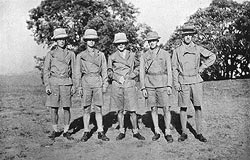 |
| The start - the party at Ranikhet, May 3rd 1937. Cpl Ridley, L/Cpls J Williams, J Bull and L Hamilton and Pte S Hillier. (Click to enlarge) |
Soldiers’ activities were much regulated by bugle calls. The most popular was the Mail Call before the arrival of the airmail service. In the late 1930s it took six to eight weeks to get a reply to a letter from England. The most tuneful call was Sunset, and it was particularly stirring when played with the accompaniment of the band and the lowering of the regimental flag. The Last Post, with its final triumphant notes, marked the end of the day and was also sounded at a soldier’s funeral, as it is today.
Leave was not often taken by soldiers. It required money and initiative. In the 1930s it became a matter of policy to encourage all ranks to take it. Holiday camps were set up. Excursions were arranged to places of interest. There were shooting and fishing expeditions. There were a number of enterprising explorations by soldiers of the foothills in the Himalayas. One in particular, which was reported in London in The Times newspaper, was by Corporal R. Ridley and four companions of 1st Surreys who set out in May 1937 from Ranikhet to climb Mount Kamel, height 25,447 feet. Self-equipped, and with no technical knowledge, they climbed to 23,500 feet before being forced back by bad weather when within one stage of the summit.
A view of the Himalayas.
(Click to enlarge)
Related
